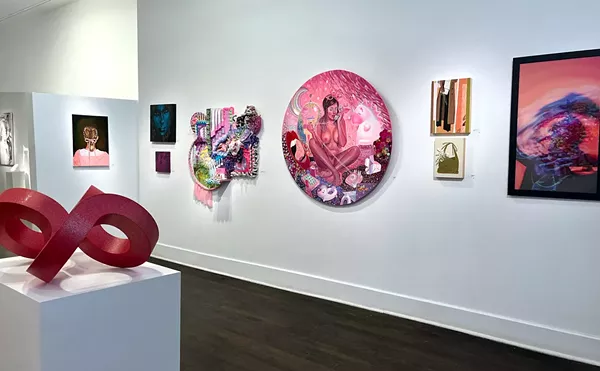
Audio By Carbonatix
[
{
"name": "GPT - Leaderboard - Inline - Content",
"component": "35519556",
"insertPoint": "5th",
"startingPoint": "3",
"requiredCountToDisplay": "3",
"maxInsertions": 100,
"adList": [
{
"adPreset": "LeaderboardInline"
}
]
}
]
As Rodney Denne opens the door to his downtown Pontiac studio, blares of Charlie Parker's K.C. Blues stampede out like a herd of buffalo. He darts to the radio, dodging paint cans and ladders along the way, and dials down the volume.
"I love jazz music," he says. "I love the idea of creating something that seems simple but is truly complex. That's what expressing the American experience is all about."
He's dressed in his "favorite" paint shirt, talks a little more jazz, his admiration for Bob Dylan, his kinship with Jack Kerouac.
Denne's studio is like him: particular. It's not the usual organized chaos of creativity where only the artist knows where to find everything. Here, things are neat, labeled, and grouped together as if Alice from the Brady Bunch stops by every night.
Denne's foray into art started during his stint in the Air Force.
"I think subconsciously it was a release, something to escape from the places I was at," he says.
Once his military days were over, Denne chose not to seek formal art schooling but instead received mentorship by longtime artist Bob Jacobson. Denne takes a seat and leans back in his raggedy chair. "I just knew I couldn't go to college and have someone tell me what to draw or how to draw it."
Denne's approach paid off. By 1998, he was creating large 66-inch by 51-inch vibrant-color abstracts and figurative paintings. "The human form is one of the most dynamic pieces of inspiration in artistic history," he says.
That same year he landed his first contract with West Bloomfield's Danielle Peleg Gallery. His relationship with Peleg has led to over a 100 paintings sold, but Denne felt the need to shift gears.
"I wanted to have more of a message so I started doing large graffiti with numbers and letters and some black-and-whites with mixed media," he says, pointing to three large pieces still in progress.
You can loosely categorize Denne as representational/cubismish, but that's for lack of other options. He'll spend four hours on an 8-by-10 drawing that's merely a puzzle piece to a bigger vision and routinely creates his own letter and number stencils. He also embraces all the tools that are available to him.
"I love oil sticks, but I like house paint because whether it's a matte format or bright, it's just durable," he says, pulling out boxes and boxes of various types of paint.
The images of cars, shapes, nature, robotics, and human body parts are strategically placed throughout his work. It's hard to find a starting point because Denne labors to paint nuances and distractions inside his work.
"I incorporate a lot of shapes that symbolize grounding, text for communication, and I like to use strong colors that affect people's way of thinking."
Though he feels below the radar, Denne has been commissioned by the Kresge Foundation, Mars advertising, and the Penske family.
"Ultimately," he says, "I want a retrospective of my work at the DIA. That's my life's goal, and that's what I'm working towards."
Kahn Santori Davison is an art maniac and lover of all machines that produce sound.






